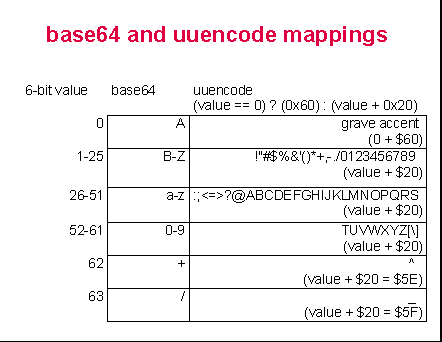
Data encodings used to transmit binary information via text only systems (email, etc...)
| Name / c code | RFC | Length | Description | Size increase |
| uuXXcode uuencode/decode. | 3 bytes to 4 | 24 bits grouped in 4 6 bit chunks using " " to "_" (20h-5Fh). uuencode uses characters that are transformed by some email gateways (e.g. some convert between EBCDIC and ASCII which do not entirely overlap), and there are also several incompatible versions of uuencode including some that map " " to "`". Oldest | ~42% | |
| Mime base64 encode / decode. | 2045, 1421 as PEM (Privacy Enhanced Mail). | 3 bytes to 4 | 24 bits grouped in 4, 6 bit chunks using A...Z, a...z, 0...9, +, /, =. Output broken in to 64 character lines. The character "=" is used to pad the final group to a full 24 bits. It is translated to nul. Safest | ~37% |
| Quote Printable encode / decode. | 2045 | 1 byte to 3 or 1 | 20h to 7Eh passed through, others in form =xy[z] where x and y are single hex digits using 0...F hex and z is the optional character that is passed through without encodeing. Least impact on data that is already mostly printable. | 3...200% |
| Charset iso-8859-1 7-bit encoding. | 1 byte to 5 or 1 | 20h to 7Eh passed through, others in form &#nnn [z] where nnn is the decimal value of the byte and z is the optional character that is passed through without encodeing. Stupidest? | 10...500% | |
| BinHex | 1741 | 3 to < 4 | 24 bits grouped in 4, 6 bit chunks using !...-, 0...9, @...[, `...r simple RLE compression. Best for data with many repeating values. |
0...40% |
| aencode | 3 bytes to 4 | 24 bits grouped in 4, 6 bit chunks using A...Z, a...z, 0...9, (, ), =. Variation of Base64 | ||
| base85 | adobe | 4 bytes to 5 | From the PostScript Developers Manual Section 4.8.2 ASCII85Decode filter:
(thanks to Jason Harper
)
This filter decodes data that has been encoded in the ASCII base- 85 encoding and produces binary data. Most effecient use of available characters when encoding truly binary data. Least Safe. Adobe technical support database notes that you may need to use mime (Base64) encoding to send pdf files on AOL. |
~25% |
NPL c code for mime encode with Base64 and Quote Printable
MASM 32 bit code for a base64 variant

see also:
MIME (Multi-purpose Internet Mail Extensions) comprises the IETF specifications RFC 822 (?)(now RFCs 2045 to 2049)
The Base64 Content-Transfer-Encoding is designed to represent arbitrary sequences of octets in a form that need not be humanly readable. The encoding and decoding algorithms are simple, but the encoded data are consistently only about 33 percent larger than the uncoded data. This encoding is virtually identical to the one used in Privacy Enhanced Mail (PEM) applications, as defined in RFC 1421.
UUencode is a text-based binary encryption protocol in wide use for the transfer of 8 bit binary files via the 7-bit Internet.
Bin/Hex is the protocol used to transfer both resource and data forks.
See:
Comments:
| file: /Techref/method/encode.htm, 8KB, , updated: 2018/2/1 16:38, local time: 2025/10/22 23:18,
216.73.216.53,10-2-207-162:LOG IN
|
| ©2025 These pages are served without commercial sponsorship. (No popup ads, etc...).Bandwidth abuse increases hosting cost forcing sponsorship or shutdown. This server aggressively defends against automated copying for any reason including offline viewing, duplication, etc... Please respect this requirement and DO NOT RIP THIS SITE. Questions? <A HREF="http://techref.massmind.org/techref/method/encode.htm"> Data encodings</A> |
| Did you find what you needed? |
Welcome to massmind.org! |
|
Ashley Roll has put together a really nice little unit here. Leave off the MAX232 and keep these handy for the few times you need true RS232! |
.